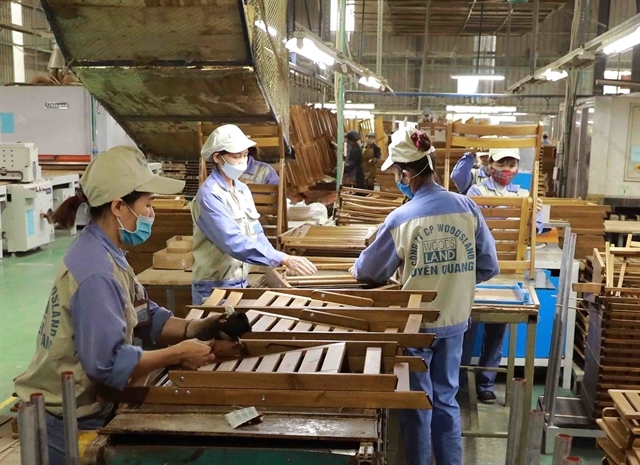Timber exporters face a sharp decline in orders
Vietnamese wood and wooden furniture enterprises have been facing many difficulties as export orders have dropped 50-60% since the beginning of this year, pushing firms to cut off at least half of their production capacities.

Data from the General Department of Customs showed that the export turnover of wood and wooden products reached US$3.9 billion in the first four months, down 30.6% year-on-year. The export of wooden goods saw a yearly decline of 38% to US$2.6 billion.
At the same time, the import value of wood and wooden products also decreased significantly to US$634 million, down 33.6% over the same period last year.
During the four months, Vietnamese exports of these goods to major markets all decreased sharply such as the US (US$2.02 billion, 38%); Japan (US$556 million, 1.5%); the Republic of Korea (US$274 million, 22%) and China (US$481 million, 13%).
Analysts and businesses have said that the decrease in wood and wooden goods exports was foreseeable. They attributable the decline to inflation surges in some countries, which were also major importers of Vietnam's wood and wooden goods, resulting in sluggish demand for these products.
For example, the US imported US$1.24 billion worth of timber and wooden products from Vietnam in the first three months, a year-on-year drop of 42%.
In the context of inflation and the banking crisis, US banks have tightened credit, making importers unable to finance import goods in large quantities. The demand for US wooden furniture imports has plummeted, analysts said.
According to wood exporters, their export orders from the US market have decreased between 50% and 55% depending on the type of wood products. Meanwhile, orders from the EU - another key export market, also dropped 60%.
Chairman of Binh Duong Woodworking Association Nguyen Liem said amid the current difficult context, the provincial wood enterprises had slashed their production capacities by 60%.
“The current global economic situation is very unpredictable," Liem said. "All market signals are not bright, and it is hard for wood enterprises to draw up their business plans.”
Liêm also predicted that when the market situation improved, and the inventory decreased, foreign customers would continue to order but not sooner than early 2024.
Around the beginning of 2024, the market would be less difficult, and businesses would have export orders again. Still, only small ones, he said, forecasting that the market would likely recover at the end of 2024. However, the recovery growth would depend on the world's economic and political situation.
Maintaining key outlets
Despite a sharp slump in orders, trade experts said the US remained a key export outlet for Vietnam's wood industry. Therefore, businesses needed to maintain the US market by updating information and converting production according to the market's consumption trends.
In addition, management agencies needed to support businesses to bring Vietnamese wooden goods into large distribution systems such as Walmart, Costco and Amazon. This was an effective way for the firms to develop their brands, avoiding relying too much on intermediaries, trade experts said.
In the current context, the Ministry of Industry and Trade and the Ministry of Foreign Affairs should continue to help businesses find out information about the market situation of products, consumer demand and tastes, Liem suggested.
They should also support the enterprises in updating the national mechanisms and policies of importing countries on quality, design, legality and sustainability of imported wood products and providing them with information on requirements as well as changes in the trade policy of key markets such as the US, the EU and Northeast Asia, he said.
The chairman added that early warnings from the ministries to help the firms minimise commercial disputes should also be included.
Chairman of the Vietnam Timber and Forest Products Association Do Xuan Lap proposed to the Ministry of Foreign Affairs and the Vietnamese embassies in foreign countries to better promote international furniture fairs in Vietnam.
Meanwhile, embassies should also provide information and support Vietnamese businesses to participate in international furniture fairs, Lap said.
He also petitioned the embassies to assist wood enterprises in opening companies, representative offices and stores in potential export markets.
